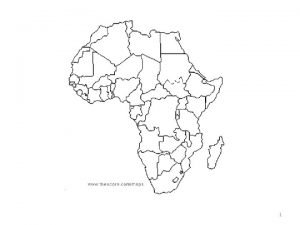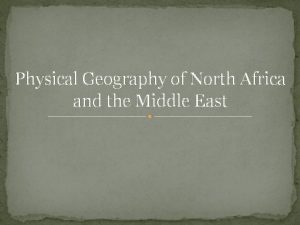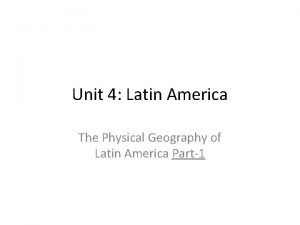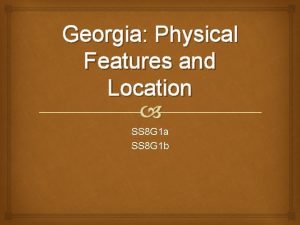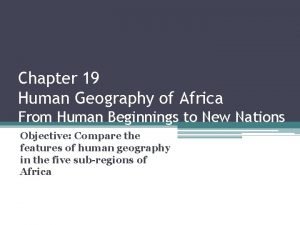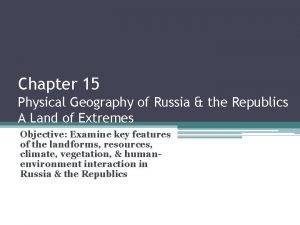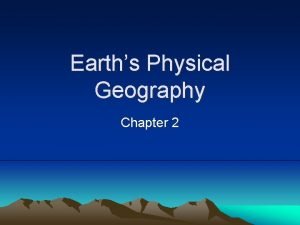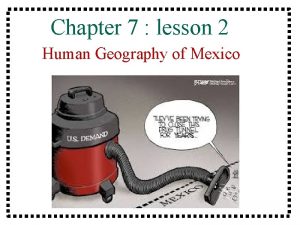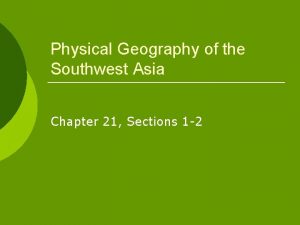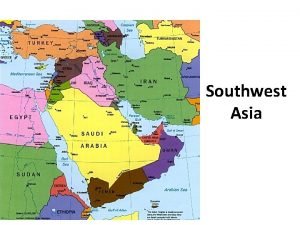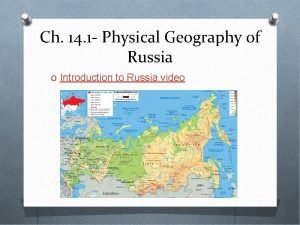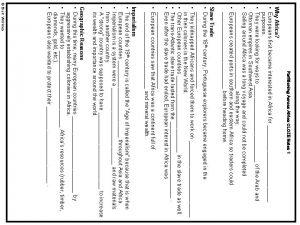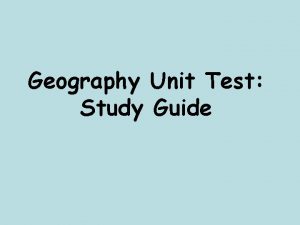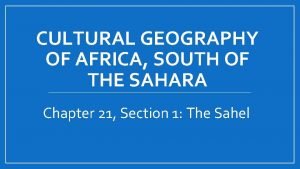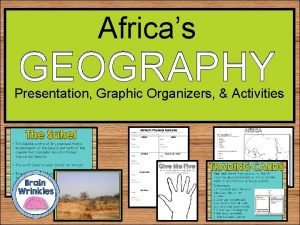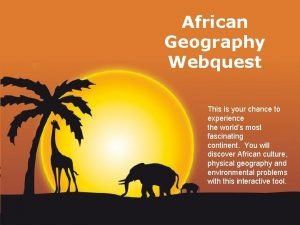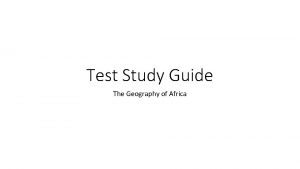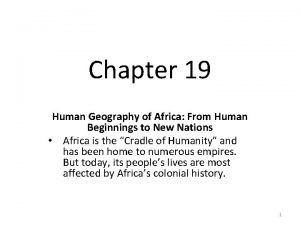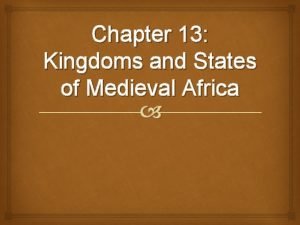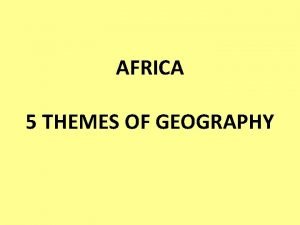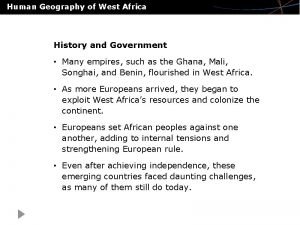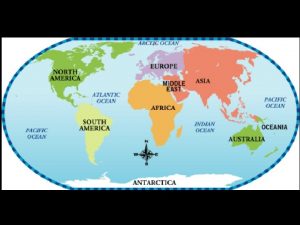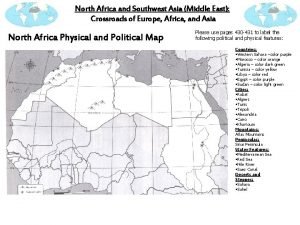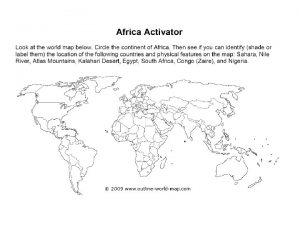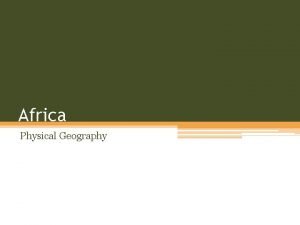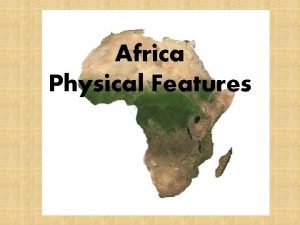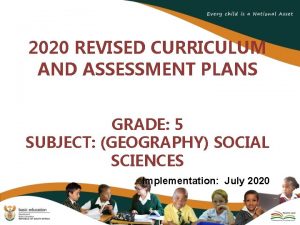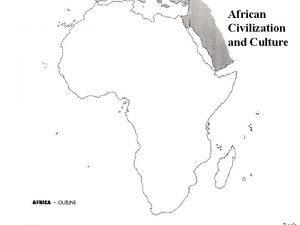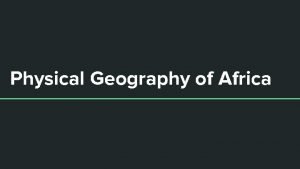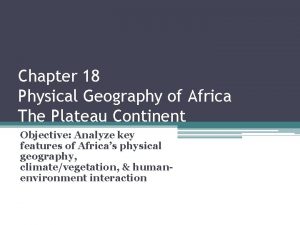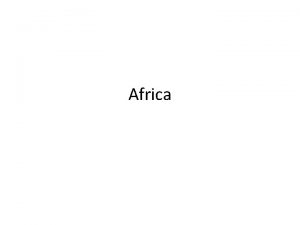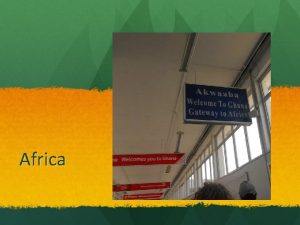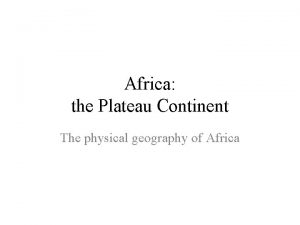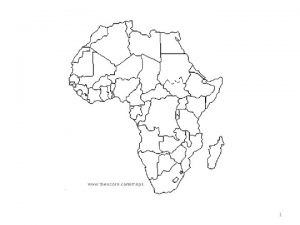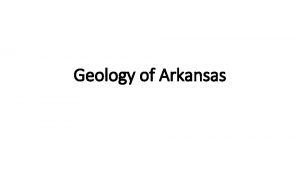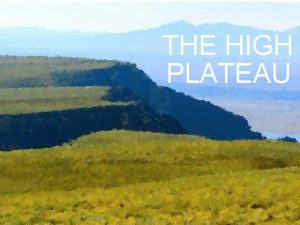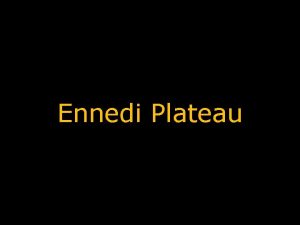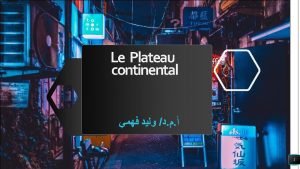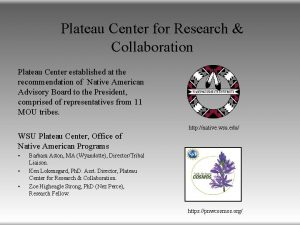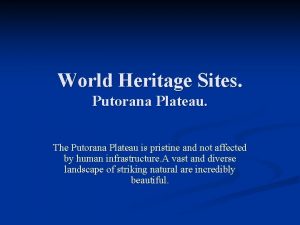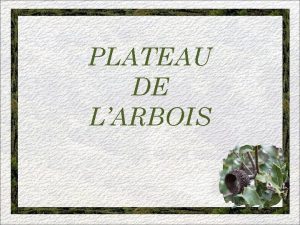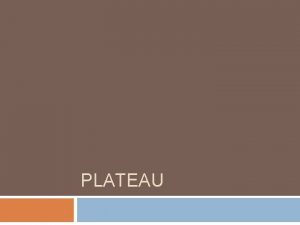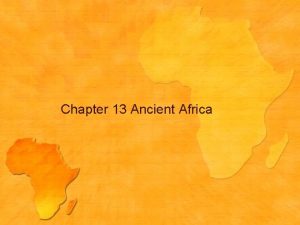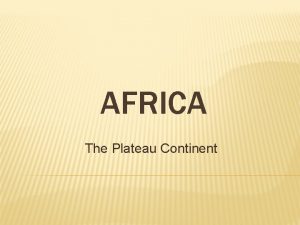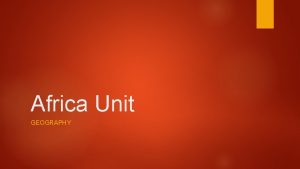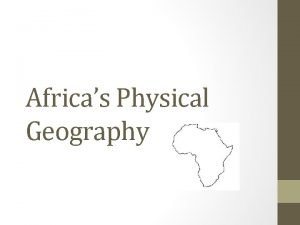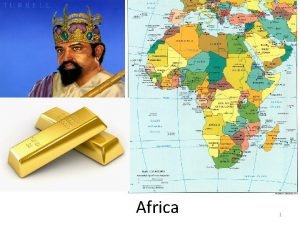Physical Geography of Africa Chapter 18 The Plateau





































- Slides: 37

Physical Geography of Africa Chapter 18 - The Plateau Continent


Section 1: Landforms & Resources • Plateau- land area with a flat surface considerably higher than the surrounding area • Plateaus are Africa’s most prominent physical features • Basin- depressions in the land in a plateau, usually has rivers or lakes in this area

Section 1: Landforms & Resources • Nile River- world’s longest river • covering more than 4, 000 miles • Africa’s rivers- many are not useful for transportation because they have too many waterfalls, & rapids • What does this mean for the economy? Makes it difficult to transport goods

Section 1: Landforms & Resources • Rift Valleys- long valleys formed by cracks between continental plates. • Large lakes & rivers have formed in these areas • Lake Tanganyika is the longest freshwater lake in the world located within the rift valley

Section 1: Landforms & Resources • Mount Kilimanjaro- Africa’s highest mountain (volcano) • Escarpment- steep slope with a nearly flat plateau on top • Marks the edge of the continent in the South.

Section 1: Landforms & Resources • Resources- Africa is very rich in natural resources, but has had trouble developing the industries. • Blood Diamonds • Colonialism • Due to European colonial rule, African nations have been slow to develop the infrastructure & industries to turn the resources into valuable products

Section 1: Landforms & Resources • Africa has large quantities of gold, platinum, chromium (used for stainless steel), cobalt, copper, phosphates, diamonds, & other minerals • Libya, Nigeria, Algeria & Angola have oil reserves (use money to fund civil wars)

Diversity of Resources • What are the two profitable commodities besides oil? Coffee and lumber • Coffee is the most profitable commodity in Africa • They grow 20% of the world’s supply • Other major commodities include sugar, palm oil, & cocoa (world’s largest exporter) How do most Africans earn their living? 66% of Africans earn their living from farming • Most important economic activity in Africa

Create a two-column chart Resources (10) Ex. Gold Uses money, jewelry, decoration

Section 2: Climate & Vegetation • Sahara- largest desert in the world. Means desert in Arabic • Over 122°F during day & below freezing at night in the winter • Aquifers- huge stores of underground water. • 6, 000 feet below the Sahara

Section 2: Climate & Vegetation • Oasis- water that reaches the surface from an aquifer in the desert

Section 2: Climate & Vegetation • Natural Vegetation of Africa

Section 2: Climate & Vegetation • Serengeti Plain- tropical grassland • Ideal for grazing animals

Section 2: Climate & Vegetation • Canopy- uppermost layer of branches (about 150 ft. above ground), in the rainforest. • Many species of plants & animals.

Section 3: Human-Environment Interaction • Sahel- narrow band of dry grassland on the southern edge of the Sahara.

Section 3: Human-Environment Interaction • Desertification- expansion of dry conditions into moist areas that are next to deserts. • Major problem for the Sahel region

Section 3: Human-Environment Interaction • Aswan High Dam • Controls the Nile River • Lake Nasser was created behind it • Finished in 1970 • Benefits • Fewer floods • More farmable land

Section 3: Human-Environment Interaction • Problems • • • More standing water Evaporation Malaria More Salt Less Silt

Section 3: Human-Environment Interaction • Silt- very fertile sediment, that is deposited on the soil after floods

















 Lesson 1 physical geography of southeast asia
Lesson 1 physical geography of southeast asia Plateaus in africa and where they are found
Plateaus in africa and where they are found North africa physical geography
North africa physical geography Kums definition geography
Kums definition geography Physical geography of west africa
Physical geography of west africa Mato grosso plateau physical map
Mato grosso plateau physical map Georgia physical features
Georgia physical features Chapter 19 section 1 east africa
Chapter 19 section 1 east africa Chapter 18 the plateau continent
Chapter 18 the plateau continent Chapter 27 physical geography of east asia
Chapter 27 physical geography of east asia Chapter 15 physical geography of russia and the republics
Chapter 15 physical geography of russia and the republics The barren rocky topography
The barren rocky topography Earth's physical geography chapter 2
Earth's physical geography chapter 2 Lesson 2 human geography of canada
Lesson 2 human geography of canada States west of the mississippi river
States west of the mississippi river Chapter 8: the physical geography of latin america answers
Chapter 8: the physical geography of latin america answers Chapter 21 physical geography of southwest asia
Chapter 21 physical geography of southwest asia Chapter 21 physical geography of southwest asia
Chapter 21 physical geography of southwest asia Reteaching activity 14 physical geography of russia
Reteaching activity 14 physical geography of russia European partitioning across africa answer key
European partitioning across africa answer key Temperate zone
Temperate zone Cultural geography of africa
Cultural geography of africa Africa's geography comprehension check answer key
Africa's geography comprehension check answer key Africa geography webquest
Africa geography webquest Africa geography unit test study guide
Africa geography unit test study guide Human geography of africa
Human geography of africa Medieval africa geography
Medieval africa geography 5 themes of geography africa
5 themes of geography africa Medieval africa geography
Medieval africa geography Human geography of west africa
Human geography of west africa Sub saharan africa physical features
Sub saharan africa physical features North africa and southwest asia physical map
North africa and southwest asia physical map Major physical features of africa
Major physical features of africa 8 major physical regions of africa
8 major physical regions of africa Physical features of africa
Physical features of africa Physical features of south africa grade 5
Physical features of south africa grade 5 Outline physical map of africa
Outline physical map of africa Africa landforms
Africa landforms

